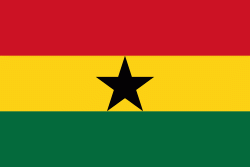Mfantsiman Municipal District (Mfatseman)
The Mfantsiman municipality is located along the Atlantic coastline of the Central Region of Ghana and extends from latitudes 5° to 5°20’ north of the equator and longitudes 0°44’ to 1°11’ west of the Greenwich Meridian, stretching for about 21 kilometers along the coastline and for about 13 kilometers inland and constituting an area of 612 square kilometers. The municipal capital is Saltpond.
The municipality is bounded to the west and northwest by Abura-Asebu-Kwamankese District, to the east by Ekumfi District and to the south by the Atlantic Ocean. The District as of 2012 started from Mankessim to Yamoransa.
Map - Mfantsiman Municipal District (Mfatseman)
Map
Country - Ghana
 |
 |
| Flag of Ghana | |
The Bono state existed in the area that is modern day Ghana during the 11th century. Kingdoms and empires such as Kingdom of Dagbon in the north and the Ashanti Empire in the south emerged over the centuries. Beginning in the 15th century, the Portuguese Empire, followed by other European powers, contested the area for trading rights, until the British ultimately established control of the coast by the 19th century. Following over a century of colonial resistance, the current borders of the country took shape, encompassing 4 separate British colonial territories: Gold Coast, Ashanti, the Northern Territories, and British Togoland. These were unified as an independent dominion within the Commonwealth of Nations. On 6th March 1957, Ghana became the first country in Sub-Saharan Africa to achieve sovereignty. Ghana subsequently became influential in decolonisation efforts and the Pan-African movement.
Currency / Language
| ISO | Currency | Symbol | Significant figures |
|---|---|---|---|
| GHS | Ghanaian cedi | ₵ | 2 |
| ISO | Language |
|---|---|
| AK | Akan language |
| EN | English language |
| EE | Ewe language |
| TW | Twi |















